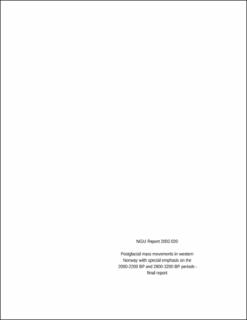| dc.description.abstract | The Ormen Lange Gas Field was discovered in the Norwegian Sea outside Møre ogRomsdal in 1997. The development of this field, which is located in the area ofthe Storegga Slide, requires safety assessment. NGU and Norsk Hydro ASA, incooperation with the University of Bergen and Sogn og Fjordane College, havecarried out a project with the aim to collect and compile data on slides,avalanches and gravitational faults that may have resulted from largeearthquakes or tsunamis in northwest Western Norway. A major task in thepresent project has been to investigate the spatial extent and interpret theorigin of a postulated mass-movement event ca. 2000 year ago and to evaluateits causes; climatic variations, a tsunami (possibly caused by an earthquakeaffecting the offshore area), an earthquake only affecting parts of westernNorway, or a combination of an earthquake and a tsunami. Several other massmovements, including Storegga Slide tsunami deposits and pre-Storegga Slideslide and debrisflow deposits have been studied, both in fjord and lakesediments.Five of the 16 investigated fjords (Dalsfjorden, Førdefjorden, Syvdsfjorden,Voldafjorden, Ørstadfjorden) provide evidence for a 2000-2200 years BP(calendar years before present, i.e. 1950) event. Previous investigations showno indication of a large shelf-edge slide in the Storegga area, that may havecreated a tsunami at that time, nor are any mass-movement deposits found onland or in the investigated lakes. This suggests that the 2000-2200 BPdebrisflows and turbidites were most likely related to one or more earthquakeson land or close to the coast, and not an offshore megaslide-generated tsunami.Storegga Slide (8200 BP) tsunami deposits are observed in cores over most ofthe investigated area, both in the deep fjords and in lakes. Strikingsimilarity between major slide and debrisflow deposits at the 2000-2200 BP andca. 11 000-11 700 BP stratigraphic levels sugges a common triggeringmechanisms, probably earthquakes with epicenters in the Sunnfjord-Sunnmøreregion. A period of debrisflows, turbidites and snow avalanches around2800-3200 BP was most probably related to climatic irregularities, as alsoobserved from previous studies elsewhere. Most of these deposits are onlyobserved in cores and not in seismic data. Clusters of rock avalanches from thesecond half of the Holocene, in Romsdalen and Tafjorden, may be related toneotectonic activity of the newly discovered Berill fault, possibly around 3000BP. Several other periods of mass-movement activity (turbidity currents,floods, snow avalanches) have been recorded, e.g. 1700-1800 BP and 5300-5600BP. These are only observed in a few basins, and are thus interpreted to berelated to local climatic variations. Clusters of rock avalanche deposits inthe coastal area probably reflect old events, possibly just after thedeglaciation. Many small debrisflows and turbidities in the early Holocene wereprobably related to rapid land uplift and high rates of erosion, at that time. | |

